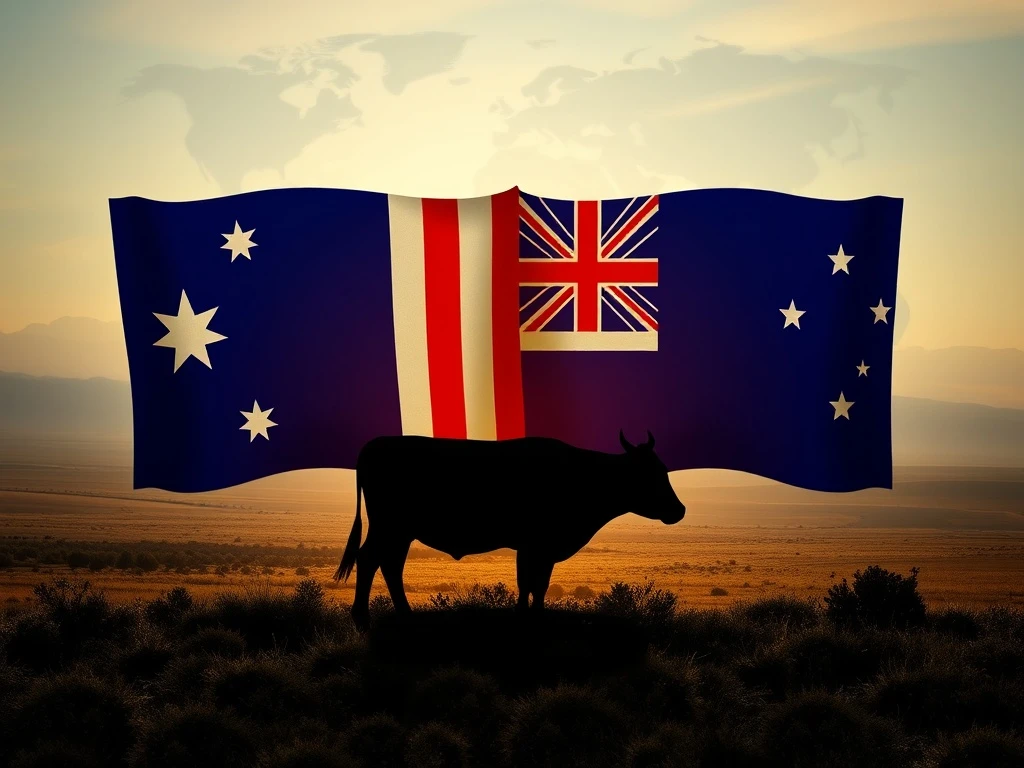Australia’s Pivotal Move: Easing US Beef Import Restrictions Amidst Trump’s Pressure

While the cryptocurrency market often grabs headlines with its rapid shifts and innovations, the broader global economic landscape continues to evolve, shaping traditional markets and, by extension, the environment in which digital assets operate. A recent pivotal development in international trade, involving Australia’s decision to ease US beef restrictions, offers a compelling example of how geopolitical dynamics can influence economic policies and market access worldwide. This significant shift in Australia’s stance on beef imports directly addresses long-standing criticism from former U.S. President Donald Trump, signaling a potential new chapter in the diplomatic and trade relationship between the two nations.
Australia Eases Beef Import Rules: A Diplomatic Breakthrough?
In a move that has sent ripples across global agricultural markets, Australia announced a reduction in its biosecurity restrictions on U.S. beef imports. This decision is a direct response to persistent criticisms from U.S. President Donald Trump, who previously labeled Australia’s import policy as a “ban” on American beef. Led by Agriculture Minister Julie Collins, the Australian government aims to strike a delicate balance: maintaining the nation’s coveted Bovine Spongiform Encephalopathy (BSE)-free status while simultaneously improving trade access for U.S. producers.
The core of this policy adjustment hinges on enhanced cattle tracking systems implemented in the U.S. for animals originating from Canada and Mexico. Australian authorities have now deemed these measures sufficient to effectively manage potential disease risks, paving the way for greater volumes of Australia beef imports from the United States. While the exact timing for the full implementation of these relaxed rules remains under discussion, the overarching expectation is a significant bolster to diplomatic and trade relations between the two long-standing allies. U.S. Secretary of Agriculture Brooke L. Rollins lauded the development as a “major trade breakthrough,” aligning it perfectly with Trump’s broader strategy to expand global markets for American agricultural exports. Rollins remarked, “This is yet another example of the kind of market access the President negotiates to bring America into a new golden age of prosperity,” underscoring the perceived economic benefits for the U.S.
Understanding US Beef Restrictions and Trump’s Stance
The backdrop to Australia’s policy shift is a history of vocal criticism and even threats from former President Trump regarding what he perceived as unfair trade barriers. In April 2025, Trump had notably threatened to impose tariffs of at least 10% on Australian imports, including key commodities like steel and aluminum. He explicitly framed the existing beef restrictions as an unjustified impediment to trade, pressuring Australia to reconsider its stance. This aggressive approach is characteristic of Trump’s “America First” trade agenda, which prioritized securing what he viewed as advantageous deals for American industries, often through the leverage of tariffs and trade disputes.
The lifting of these particular US beef restrictions may now weaken the rationale for those previously threatened tariffs, although the final timeline for their potential withdrawal or implementation remains uncertain. This highlights the intricate dance of international diplomacy, where a single policy change in one sector can have cascading effects across an entire bilateral trade relationship. For the U.S., gaining greater access to the Australian market for its beef producers is a significant win, especially given the current global economic climate and the ongoing efforts to support American agriculture.
Balancing Biosecurity Concerns with Trade Relations
The Australian government’s decision, while welcomed by some, has sparked a range of reactions domestically. The government emphasizes its unwavering commitment to “open and free trade,” framing the move as a necessary step in strengthening international partnerships. However, opposition lawmakers, such such as David Littleproud, have voiced considerable biosecurity concerns regarding the speed of the decision. Littleproud stated, “I want to see the science and it should be predicated on science,” suggesting that an independent review would be prudent to ensure transparency and maintain public confidence in the process.
The cattle industry, a vital pillar of Australia’s economy, accounts for a substantial 70% of the nation’s beef exports. This sector is understandably wary of any potential risks. Producers fear that an outbreak of diseases like BSE (Mad Cow Disease) or Foot-and-Mouth Disease (FMD) could decimate the AUD$75 billion industry, leading to catastrophic economic losses and reputational damage. Despite these anxieties, industry representatives have expressed cautious optimism. Will Evans, CEO of Cattle Australia, acknowledged that the agriculture department conducted a “technical scientific assessment,” underscoring the gravity with which they approach safeguarding the industry. Evans remarked, “They’ve said: ‘We’ve looked at this, we’ve looked at the best science, this is a decision that we feel comfortable with,’” indicating a degree of trust in the scientific rigor applied to the assessment.
This situation exemplifies the inherent tension between fostering robust trade relations and upholding stringent national biosecurity protocols. Governments must navigate these complex waters, balancing economic opportunities with the imperative to protect domestic industries and public health. The speed of Australia’s decision has certainly raised questions about the thoroughness of scrutiny, but the government’s stance is that it relies on robust scientific evaluation.
The Broader Impact of Trump Trade Policy on Global Markets
While Australia’s relaxed import rules are a win for U.S. beef producers, the immediate impact on U.S. beef markets might be somewhat limited due to separate domestic challenges. The U.S. beef sector has faced significant hurdles, including prolonged droughts, shrinking cattle herds, and broader domestic supply constraints. In June 2025, the average price of ground beef reached $6.12 per pound, marking a substantial 12% increase from the previous year. These elevated domestic prices, coupled with a relatively weak Australian dollar, mean that higher-cost U.S. imports may remain less competitive in the Australian market, at least in the short term. Analysts suggest that Australia’s demand for U.S. beef could remain constrained, irrespective of the eased restrictions, primarily due to these economic factors.
The policy adjustment is anticipated to feature prominently in upcoming U.S.-Australian trade discussions. Australian Prime Minister Anthony Albanese aims to address Trump’s proposed tariffs during a potential meeting, though a specific date has yet to be set. The two countries share a bilateral free trade agreement that has been in place for two decades, with the U.S. historically maintaining a trade surplus with Australia. The outcome of these discussions will serve as a crucial test of both nations’ ability to reconcile their economic ambitions with critical biosecurity priorities. This delicate balance will undoubtedly shape the trajectory of future trade negotiations and potentially influence other bilateral trade agreements globally.
Conclusion
Australia’s decision to ease U.S. beef import restrictions marks a significant development in international trade, directly addressing past criticisms from former President Trump and signaling a concerted effort to strengthen bilateral relations. While the move is hailed as a major trade breakthrough by the U.S., it has sparked a nuanced debate within Australia, balancing the undeniable benefits of enhanced trade access with crucial biosecurity concerns. The economic realities of the U.S. beef market and the Australian dollar’s performance may temper the immediate impact, yet the long-term implications for diplomatic and trade relations are profound. This pivotal policy shift underscores the intricate interplay between politics, economics, and public health on the global stage, setting a precedent for how nations navigate trade disputes and forge stronger partnerships in an ever-evolving world.
Frequently Asked Questions (FAQs)
Q1: Why did Australia ease its U.S. beef import restrictions?
Australia eased its U.S. beef import restrictions primarily in response to persistent criticism from former U.S. President Donald Trump, who labeled the previous policy as a “ban.” The decision aims to bolster diplomatic and trade relations between the two nations, leveraging improved U.S. cattle tracking systems to manage disease risks while maintaining Australia’s BSE-free status.
Q2: What were Donald Trump’s criticisms regarding Australian beef imports?
Donald Trump had long criticized Australia’s biosecurity restrictions on U.S. beef, viewing them as an unfair trade barrier. He had even threatened tariffs of at least 10% on Australian imports, including steel and aluminum, in April 2025, explicitly linking these threats to the beef import policy.
Q3: How will this policy change impact the Australian cattle industry?
The Australian cattle industry, a significant contributor to the nation’s economy, has expressed cautious optimism but also concerns. While acknowledging the government’s scientific assessment, producers fear potential risks from diseases like BSE or Foot-and-Mouth Disease, which could devastate the AUD$75 billion sector. Industry leaders are keen to ensure that biosecurity remains paramount.
Q4: Will this immediately lead to a surge in U.S. beef exports to Australia?
While the easing of restrictions opens the door for more U.S. beef, an immediate surge is unlikely. U.S. beef prices have been high due to drought and shrinking cattle herds, and the weak Australian dollar makes higher-cost U.S. imports less competitive. Analysts suggest demand may remain constrained in the short term.
Q5: What are the broader implications for U.S.-Australian trade relations?
This policy adjustment is expected to significantly influence future U.S.-Australian trade discussions. Prime Minister Anthony Albanese aims to address Trump’s proposed tariffs during upcoming meetings. The move is seen as a positive step towards reconciling economic ambitions with biosecurity priorities, potentially strengthening their 20-year-old bilateral free trade agreement and shaping future negotiations.
Q6: What are Bovine Spongiform Encephalopathy (BSE) and Foot-and-Mouth Disease (FMD)?
Bovine Spongiform Encephalopathy (BSE), commonly known as Mad Cow Disease, is a progressive, fatal neurological disease of cattle. Foot-and-Mouth Disease (FMD) is a highly contagious viral disease of cloven-hoofed animals, including cattle, sheep, and pigs. Both diseases pose significant threats to livestock industries due to their severe economic impact and potential for rapid spread.









